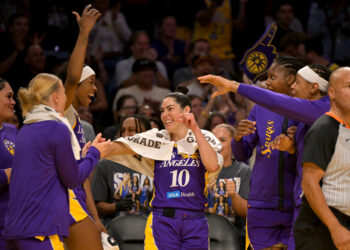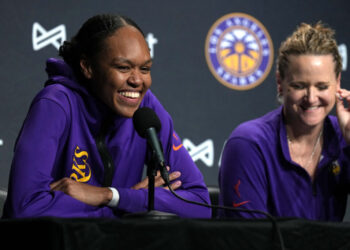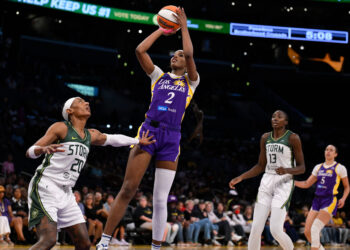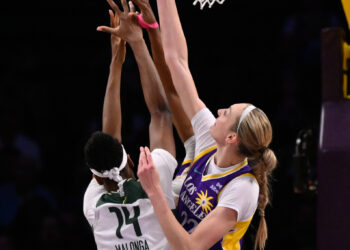We’ll begin our weekly Tankathon Check-ins next Sunday.
Atlanta Dream
The Dream shrink way too much on defense. I understand that Tanisha Wright coaches with a singular focus on the paint on both ends — there’s a reason she’s derided the idea of playing Rhyne Howard at the 4, thinks Nia Coffey is a guard, and is starting two borderline-starting-caliber centers together. But the Dream just shrink way too much on defense.
Want even more women’s sports in your inbox?
Subscribe now to our sister publication The IX and receive our independent women’s sports newsletter six days a week. Learn more about your favorite athletes and teams around the world competing in soccer, tennis, basketball, golf, hockey and gymnastics from our incredible team of writers.
Readers of The Next now save 50% on their subscription to The IX.
Shrinking is often appropriate, but doing it all the time is counterproductive. Take this week’s game against Washington for example. Early in the second quarter, Ariel Atkins takes a handoff from Shakira Austin and, with her defender trailing over, drives into the paint. Aerial Powers commits to helping on the stunt and Haley Jones slides all the way in to protect the rim, both of which are perfectly good ideas because there is only one Mystic on the court who is a credible shooting threat and she’s the one with the ball. Plus, Atkins is a poor playmaker, so she’s unlikely to take advantage of the rotations anyway.
But just a quarter earlier, Atlanta committed to a highly exaggerated version of their shrinking issue. On Washington’s first offensive possession of the game, Julie Vanloo gets by Tina Charles’ ICE coverage1. This definitely requires a help rotation for the Dream to correct, but it should not require all five defenders having both feet in the paint, especially when Vanloo is not a standout finisher at the rim and three excellent shooters are being left wide open.
I’m sure Wright is not instructing her players to shrink, no matter their assignment, whenever there is a hint of dribble penetration. But this is a team that badly needs to clean up its help assignments and off-ball rotations, and has had to do so for two years running.
Connecticut Sun
The Sun have an awkward fit in their starting lineup, but you didn’t need me to tell you that. Between Alyssa Thomas, DeWanna Bonner and Brionna Jones, you’ve got two non-shooters and a third who is far more of a volume 3-point shooter than an accurate one.
Stephanie White is making it work, though. Connecticut is 7-0 for the first time in franchise history, per Sports Reference, with the best offensive rating in the league. How White is making that work is something I am reliably informed that people smarter than me are working on, so I will leave the bigger picture to them. For now, I just want to look at a funny paradox about this team: As good as the frontcourt trio of Thomas, Bonner and Jones is, playing them all together places an immense amount of pressure on the guards alongside them.
Since Bonner joined the Sun, the trio of her, Thomas and Jones has a +12.1 net rating in over 1,200 minutes, per PBP Stats. But that rating varies wildly by their backcourt partners. Excluding minutes they played with Jonquel Jones, minutes which came in jumbo lineups that operated outside the normal bounds of basketball, the trio’s net rating with various guards who played significant minutes over the past five years:
All due respect to Harris, but sorting that list by net rating puts those players in a different order than an overall ranking would. This is indicative of the fact that certain skills that are needed to make the Bonner-Thomas-Brionna Jones trio work above all else: significant shooting gravity, impactful connective passing and quick decision-making. Without those skills, defenses are able to make much easier help rotations against Connecticut.
This should make some measure of intuitive sense. The issue with playing the Bonner-Thomas-Jones trio together is that defenses can shrink to the paint without worrying about closing-out to a bevy of outside threats, but Thomas and Jones can still force defenses to respect their presence away from the cup through screening and passing — if the players they screen for or pass to are threats against long closeouts.
Celebrate the WNBA’s 28th season!
Get started with a paid subscription to The Next, which helps support all of our writers, editors and photographers who work tirelessly to bring you this coverage. In honor of the WNBA’s 28th season, we are offering memberships for 28% off. That’s only $51.84 to get exclusive access to everything we have to offer for a year!
When Thomas and Jones are used as off-ball screeners, the guard they’re screening for needs to be a legitimate shooting threat who moves without the ball into passing windows so that she maximizes the threat of her spot-up shot.
When Thomas and Jones’ connective passing gives a guard a closeout/rotation to attack, she needs to be seeing and thinking quickly before the ball even gets to her so that she can press the advantage she gets, either by continuing to swing the ball or dribbling inside before pulling up or kicking out. Because in any case, there is no bailout help for the Sun guards — the guards are the bailout. If they can’t make defenses pay, then the whole system grinds to a halt.
Minnesota Lynx
After a 95-71 drubbing of a weary Phoenix team Friday night, the Lynx now sit second in the WNBA in both net rating and points per game2 and first in defensive rating. I find the defensive end of things slightly less interesting, for two reasons:
- It makes sense that a starting lineup whose worst defender is Kayla McBride would be a damn good defensive unit; and
- Minnesota’s benefited from an advantageous schedule, since its clear defensive vulnerability is star centers. It’s a combined 1-2 against the three toughest front court matchups in the league: Las Vegas, New York and Connecticut.
The last time the Lynx ranked top-two in scoring average, their starting lineup featured five future Hall of Famers, and the regular backups were all notable names. That was 2016, the fourth time in five years that Minnesota ranked top-two. It maintained that starting lineup for two more years, but the offense dropped off precipitously.
So what’s new this year? You might guess it’s the offensive structure, since Cheryl Reeve and co. are for the first time working with a frontcourt that excels in space but isn’t too imposing in the post. But Reeve has long had Minnesota playing with lifted bigs and balanced spacing (as opposed to overloading the strong or weakside). It’s likely part of why the Lynx targeted Janel McCarville and Asjha Jones to fill the center spot before they traded for Sylvia Fowles; Reeve even lifted Taj McWilliams-Franklin, who’s far from an archetypical pinch post.
You might guess what’s changed, then, is the offensive scheme. But Minnesota seems largely to be running the same sets as last year, from their high post series …
… to their horns action …
… so, with the exception of Napheesa Collier’s increasingly Candace Parker-ized usage, the scheme seems to have remained mostly the same.
The difference this year is a lot of little things coming together. The front court combo of Collier and Alanna Smith stretches defenses both vertically, where both players are savants at timing and angles in the pick-n-roll, and horizontally, where they combine for nearly six 3-point attempts per game and are both excellent at creating space by moving without the ball. The Lynx have never had a front court before who could do that.
The increased threat that Collier and Smith pose pulls defenders away from the paint and forces rotations or full-blown switches that open up windows elsewhere in the offense. And while no one in the backcourt rotation of Courtney Williams, Bridget Carleton, Natisha Hiedeman and McBride is a plus playmaker for their position, most excel at “point five” basketball, so the ball simply moves faster in Minnesota’s offense than elsewhere in the W.
It also helps that the Lynx coaches continue to be damn good at installing their system and teaching reads.
Get 24/7 soccer coverage with The Equalizer
The Next is partnering with The Equalizer to bring more women’s sports stories to your inbox. Subscribers to The Next receive 50% off their subscription to The Equalizer for 24/7 coverage of women’s soccer.














